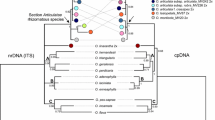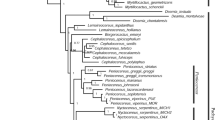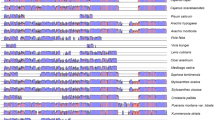Abstract
Cyathocline, a small genus, has been treated as a member of subtribe Grangeinae of tribe Astereae (Asteraceae), but has been neglected in molecular phylogenetic analyses of Astereae. Plastid trnL-F and nuclear ribosomal DNA ITS sequences were used to carry out phylogenetic analyses of Cyathocline (represented by C. purpurea) through maximum parsimony and Bayesian analyses. In addition, its karyotype, morphology and micromorphology were also investigated. The results show that in our three phylogenetic trees, C. purpurea is deeply nested within the Blumea clade and/or the Inulinae clade, and is closest to Blumea balsamifera (Inuleae, Inulinae). C. purpurea is similar to Blumea in chromosome size bimodality and to Inulinae in one single large oxalate crystal within each cell of the cypsela epidermis, which, together with molecular evidences, suggests strongly that Cyathocline should be transferred from Astereae to Inuleae subtribe Inulinae. Although C. purpurea has many anomalous features, its most characters still are within a wide range of morphological variations of Blumea. DNA data and the karyotypic character support to merge C. purpurea into Blumea. As a result, the new combination Blumea purpurea (O. Kuntze) W.P. Li was made.







Similar content being viewed by others
Notes
The data are being submitted to NCBI.
References
Anderberg AA (1991) Taxonomy and phylogeny of the tribe Inuleae (Asteraceae). Plant Syst Evol 176:75–123
Anderberg AA (2009) Inuleae. In: Funk VA, Susanna A, Stuessy TF, Bayer RJ (eds) Systematics, evolution, and biogeography of Compositae. IAPT, Vienna, pp 667–680
Anderberg AA, Eldenäs P (2007) Tribe Inuleae Cass. In: Kadereit JW, Jeffrey C (eds) The families and genera of flowering plants, vol 8. Springer, Berlin, pp 374–391
Anderberg AA, Karis PO (1995) Psednotrichia, a genus of the tribe Senecioneae hitherto misplaced in the Astereae (Asteraceae). Nord J Bot 15:375–379
Anderberg AAA, Pandey AK (2008) Nanothamnus sericeus Thomson, a derived species of Blumea. Compos Newsl 46:8–19
Anderberg AA, Eldenäs P, Bayer RJ, Englund M (2005) Evolutionary relationships in the Asteraceae tribe Inuleae (incl. Plucheeae) evidenced by DNA sequences of ndhF; with notes on the systematic positions of some aberrant genera. Org Divers Evol 5:135–146
Bayer RJ, Cross EW (2002) A reassessment of tribal affinities of the enigmatic genera Printzia and Isoetopsis (Asteraceae), based on three chloroplast DNA sequences. Aust J Bot 50:677–686
Bien LK (2007) Flora of Vietnam, vol 7. Science and Technics Publishing House, Hanoi
Bremer K (1994) Asteraceae: cladistics and classification. Timber Press, Portland
Brouillet L, Anderberg AA, Nesom GL, Lowrey TK, Urbatsch LE (2009a) Welwitschiella is a member of the African subtribe Grangeinae (Asteraceae Astereae): a new phylogenetic position based on ndhF and ITS sequence data. Kew Bull 64:645–660
Brouillet L, Lowrey TK, Urbatsch L et al (2009b) Astereae. In: Funk VA, Susanna A, Stuessy T, Bayer R (eds) Systematics, evolution and biogeography of the Compositae. IAPT, Vienna, pp 449–490
Carr GD, King RM, Powell AM, Robinson H (1999) Chromosome numbers in Compositae. XVIII. Am J Bot 86:1003–1013
Chen YS, Anderberg AA (2011) 12 Tribe Inuleae. In: Wu ZY, Raven PH, Hong DY (eds) Flora of China, vol 20–21 (Asteraceae). Science Press and Missouri Botanical Garden Press, Beijing and St. Louis, pp 820–850. http://flora.huh.harvard.edu/china/mss/volume20/Flora_of_China_Volume_20_21_Inuleae.pdf
Chen YL, Chen YS, Brouillet L, Semple JC (2011) 8 Tribe Astereae. In: Wu ZY, Raven PH, Hong DY (eds) Flora of China, vol 20–21 (Asteraceae). Science Press and Missouri Botanical Garden Press, Beijing and St. Louis, pp 545–652. http://flora.huh.harvard.edu/china/mss/volume20/Flora_of_China_Volume_20_21_Astereae.pdf
Doyle JJ, Doyle JD (1987) A rapid DNA isolation procedure for small quantities of fresh leaf tissue. Phytochem Bull Bot Soc Am 19:11–15
Eldenäs P, Kallersjo M, Anderberg AA (1999) Phylogenetic placement and circumscription of tribes Inuleae s. str. and Plucheeae (Asteraceae): evidence from sequences of chloroplast gene ndhF. Mol Phylogenet Evol 13:50–58
Englund M, Pornpongrungrueng P, Gustafsson MHG, Anderberg AA (2009) Phylogenetic relationships and generic delimitation in Inuleae subtribe Inulinae (Asteraceae) based on ITS and cpDNA sequence data. Cladistics 25:319–352
Farris JS, Kallersjo M, Kluge AG, Bult C (1994) Testing significance of congruence. Cladistics 10:315–319
Fayed A (1979) Revision der Grangeinae (Asteraceae - Astereae). Mitteilungen der Botanischen Staatssammlung München 15:450–512
Funk VA, Anderberg AA, Baldwin BG et al (2009) Compositae metatrees: the next generation. In: Funk VA, Susanna A, Stuessy T, Bayer R (eds) Systematics, evolution and biogeography of the Compositae. IAPT, Vienna, pp 750–751
Gao TG, Wang W, Bayer RJ, Li DZ (2009) Systematic position of the enigmatic genus Sheareria (Asteraceae)—evidence from molecular, morphological and cytological data. Taxon 58:769–780
Grau J (1977) Astereae-systematic review. In: Heywood VH, Harborne JB, Turner BL (eds) The biology and chemistry of the Compositae. Academic Press, London, pp 539–565
Hall TA (1999) BioEdit: a user-friendly biological sequence alignment editor and analysis program for Windows 95/98/NT. Nucleic Acids Symp Ser 41:95–98
Jeanmougin F, Thompson JD, Gouy M, Higgins DG, Gibson TJ (1998) Multiple sequence alignment with Clustal X. Trends Biochem Sci 23:403–405
Joshi A, Baghel V, Pathak AK, Tailang M (2011) Phytochemical studies of whole plant of Cyathocline lyrata Cass. Int J Pharm Stud Res 2(1):59–64
Koul AK, Wakhlu AK (1975) The chromosome numbers of Cyathocline lyrata Cass. Curr Sci 44:779–780
Koul AK, Wakhlu AK, Karihaloo JL (1976) Chromosome numbers of some flowering plants of Jammu (western Himalayas). II. Chromosome Inf Serv 20:32–33
Koul AK, Hamal IA, Wakhlu AK (1986) Cytological studies of Cyathocline lyrata Cass. J Cytol Genet 21:82–86
Li WP (2002) The biosystematic studies on the Aster ageratoides (Asteraceae) polyploid complex. Dissertation, Hunan Agricultural University, China
Li WP (2005) The cytogeography of Aster ageratoides var. laticorymbus (Asteraceae), a polyploid complex endemic to China. Bot Bull Acad Sin 46:355–361
Li WP (2006) Natural hybridization between Aster ageratoides var. scaberulus and Kalimeris indica (Asteraceae): evidences from morphology, karyotype and ITS sequences. Bot Stud 47:191–197
Li WP, Liu SX (2005a) Differentiation between Aster ageratoides var. micranthus and var. gerlachii: evidence from morphology and cytology. Acta Phytotaxon Sin 43:31–36
Li WP, Liu SX (2005b) Cytogeography of Aster ageratoides var. scabulus. Life Sci Res 9:68–72
Li ZQ, Huang R, Luo L, Ma GY (2003) Constituents of volatile oil and cytotoxicity on Cyathocline purpurea. Acta Botanica Yunnanica 25:480–481
Li ZQ, Ma GY, Luo L, Zhang XT (2005) Sesquiterpene lactones from Cyathocline purpurea. Chem J Chin Univ 27:859–862
Li WP, Zhang P, Yin GS (2008) New evidence for the tribal placement of Sheareria within Astereae (Compositae). J Syst Evol 46:608–613
Li WP, Tang M, Yin GS, Yin Y, Yang FS, Chen SM (2011) Extensive Chromosome Number Variation in Aster ageratoides var. pendulus (Asteraceae). Bot J Linn Soc 165:378–387
Li WP, Yang FS, Jivkova T, Yin GS (2012) Phylogenetic relationship and generic delimitation of Eurasian Aster (Asteraceae: Astereae) inferred from ITS, ETS and trnL-F sequence data. Ann Bot 109:1341–1357
Ling R, Chen YL, Shi Z (1985) Astereae. In: Ling R, Chen YL, Shi Z (eds) Flora Reipublicae Popularis Sinicae, vol 74. Science Press, Beijing, pp 70–353
Liu JQ, Gao TG, Chen ZD, Lu AM (2002) Molecular phylogeny and biogeography of the Qinghai–Tibet Plateau endemic Nannoglottis (Asteraceae). Mol Phylogenet Evol 23:307–325
Ma G, Chong L, Li Z, Cheung AH, Tattersall MH (2009) Anticancer activities of sesquiterpene lactones from Cyathocline purpurea in vitro. Cancer Chemother Pharmacol 64:143–152
Marhold K, Aguilera PM, Daviña JR, Honfi AI (2011) IAPT/IOPB chromosome data 12. Taxon 60:1784–1796
Nesom GL (1994a) Subtribal classification of the Astereae (Asteraceae). Phytologia 76:193–274
Nesom GL (1994b) Review of the taxonomy of Aster sensu lato (Asteraceae: Astereae), emphasizing the New World species. Phytologia 77:141–297
Nesom GL, Robinson H (2007) Tribe Astereae Cass. In: Kadereit JW, Jeffrey C (eds) The families and genera of vascular plants. Flowering plants: Eudicots: Asterales. Springer, Berlin, pp 284–342
Noyes RD, Rieseberg LH (1999) ITS sequence data support a single origin for North American Astereae (Asteraceae) and reflect deep geographic divisions in Aster s.l. Am J Bot 86:398–412
Peng CI, Hsu CC (1978) Chromosome number on Taiwan Compositae. Bot Bull Acad Sin 19:53–66
Pornpongrungrueng P, Borchsenius F, Englund M, Anderberg AA, Gustafsson MHG (2007) Phylogenetic relationships in Blumea (Asteraceae: Inuleae) as evidenced by molecular and morphological data. Plant Syst Evol 269:223–243
Ronquist F, Huelsenbeck JP (2003) MrBayes 3: Bayesian phylogenetic inference under mixed models. Bioinformatics 19:1572–1574
Shrivastava R (1979) Anthelmintic properties of essential oil of Cyathocline lyrata Cass. Indian J Pharm Sci 41:228–229
Swofford DL (2001) PAUP*: phylogenetic analysis using parsimony (*and other methods), version 4.0b10. Sinauer Associates, Sunderland
Taberlet P, Gielly L, Pautou G, Bouvet J (1991) Universal primers for amplification of three non-coding regions of chloroplast DNA. Plant Mol Biol 17:1105–1109
Tandon V, Yadav AK, Roy B, Das B (2011) Phytochemicals as cure of worm infections in traditional medicine systems. In: Srivastava UC, Kumar S (eds) Emerging trends in zoology. Narendra Publishing House, New Delhi
Tara M (1996) The structure of natural hybrid swarm between Aster and Kalimeris in Chizu-cha, Yazu-gun, Tottori Pref. Bull Sch Educ Okayama Univ 102:89–114
Watanabe K, Yahara T, Denda T, Kosuge K (1999) Chromosomal evolution in the genus Brachycome (Asteraceae, Astereae): statistical tests regarding correlation between changes in karyotype and habit using phylogenetic information. J Plant Res 112:145–161
White TJ, Bruns T, Lee S, Taylor J (1990) Amplification and direct sequencing of fungal ribosomal RNA genes for phylogenetics. In: Innis MA, Gelfand DH, Sninsky JJ, White TJ (eds) PCR protocols: a guide to methods and application. Academic Press, San Diego, pp 315–322
Wild H (1969) The Compositae of the Flora Zambesiaca area II. Kirkia 7:121–132
Yu C, Huang T, Ding Z, Gao X, Zhang Z (1993) Encyclopaedia of Chinese medicines, vol 1, item 9766. Chinese Medicinal Science and Technology Press, Beijing
Zhang XP, Bremer K (1993) A cladistic analysis of the tribe Astereae (Asteraceae) with notes on their evolution and subtribal classification. Plant Syst Evol 184:259–283
Zhuang X (2004) Astereae. In: Wu CY (ed) Flora Yunnanica, vol XIII. Science Press, Beijing, pp 46–131
Acknowledgments
We thank the reviewers for their valuable comments and suggestions; Prof. Fu-Sheng Yang for helping construct the phylogenetic trees; Dr. Gen-Shen Yin and Mrs. Ping Zhang for field assistance. This study was financed by the National Natural Science Foundation of China (Grant Nos. 30470131 and 39899400), the Hunan Provincial Construct Program of the Key Discipline in Ecology, and the Scientific Research Fund of Hunan Provincial Education Department (Grant No. 08A046).
Author information
Authors and Affiliations
Corresponding author
Appendix
Appendix
Taxa sampled and their GenBank accession numbers for the trnL-F and ITS sequences. Only new sequences obtained in this study include voucher information.
Antennaria microphylla Rydberg, HM364534, HM244731; Anvillea garcinii subsp. radiata (Coss. and Durieu) Anderb., EF211058, EF210963; Arnica cordifolia Hook., EF104923, EF104922; Aster amellus L., JN543744, JN543742; Blumea balsamifera DC., EF211053, EF210958; Blumea densiflora DC., EF211029, EF210934; Footnote 1 Blumea purpurea (Buchanan-Hamilton ex D. Don) W. P. Li, LWP1205010 (HUUN); Blumea virens DC., EF211052, EF210957; Buphthalmum salicifolium L., EF211059, EF210964; Caesulia axillaris Roxb., EF211044, EF210949; Calendula officinalis L., JN315917, JN315941; Carpesium macrocephalum Franch. et Savat., FM997839, FM995368; Chaenactis douglasii (Hook.) Hook. and Arn., GU817985, GU818511; Chrysanthemum indicum L., JN315916, JN315940; Chrysophthalmum gueneri Aytac and Anderb., FM997842, FM995370; Dichrocephala auriculata (Thunb.) Druce, JN315895, JN315919; Duhaldea eupatorioides (DC.) Steetz, EF211056, EF210961; Duhaldea nervosa (Wallich ex Candolle) Anderberg, EF211027, EF210932; Duhaldea rubricaulis (Wall. ex DC.) Anderb., FM997844, FM995372; Erato polymnioides DC., GU817999, AF539949; Eupatorium serotinum Michx., GU818001, DQ236176; Flaveria pubescens Rydb., DQ122575, DQ122498; Grangea maderaspatana (L.) Poir., JN315896, JN315920; Helenium autumnale L., GU818007, GU818553; Helianthus tuberosus L., GU818008, AF047953; Inula confertiflora A.Rich., FM997847, FM995375; Inula helenium L., FM997850, FM995377; Iphiona aucheri (Boiss.) Anderb., FM997855, FM995382; Iphiona senecionoides (Baker) Anderb., FM997858, FM995385; Lactuca canadensis L., GU818025, GU818575; Laggera alata (D. Don) Sch.-Bip. ex Oliv., EF211025, FJ980335; Lifago dielsii Schweinf. and Muschl., FM997860, FM995386; Limbarda crithmoides (L.) Dumort., FM997861, FM995387; Merrittia benguetensis (Elmer) Merr., EF211050, EF210955; Pentanema indicum (Linn.) Ling, EF211048, EF210953; Pluchea carolinensis (Jacq.) G.Don, EU385104, AF437851; Polymnia canadensis L., GU818051, AF465876; Printzia polifolia (L.) Hutch., AF098816, FJ457927; Pseudoconyza viscosa (Mill.) D’ Arcy, EF211021, EF210926; Pulicaria dysenterica (L.) Bernh., FM997870, FM995395; Senecio squalidus L., JN790007, JN789909; Stenachaenium campestre Baker, EF211026, EF210931; Vernonia gigantea (Walter) Trel., GU818102, AY142949.
Rights and permissions
About this article
Cite this article
Li, WP., Qian, FM., Yang, XL. et al. Systematic position of Cyathocline Cass. (Asteraceae): evidences from molecular, cytological and morphological data. Plant Syst Evol 300, 595–606 (2014). https://doi.org/10.1007/s00606-013-0905-8
Received:
Accepted:
Published:
Issue Date:
DOI: https://doi.org/10.1007/s00606-013-0905-8




